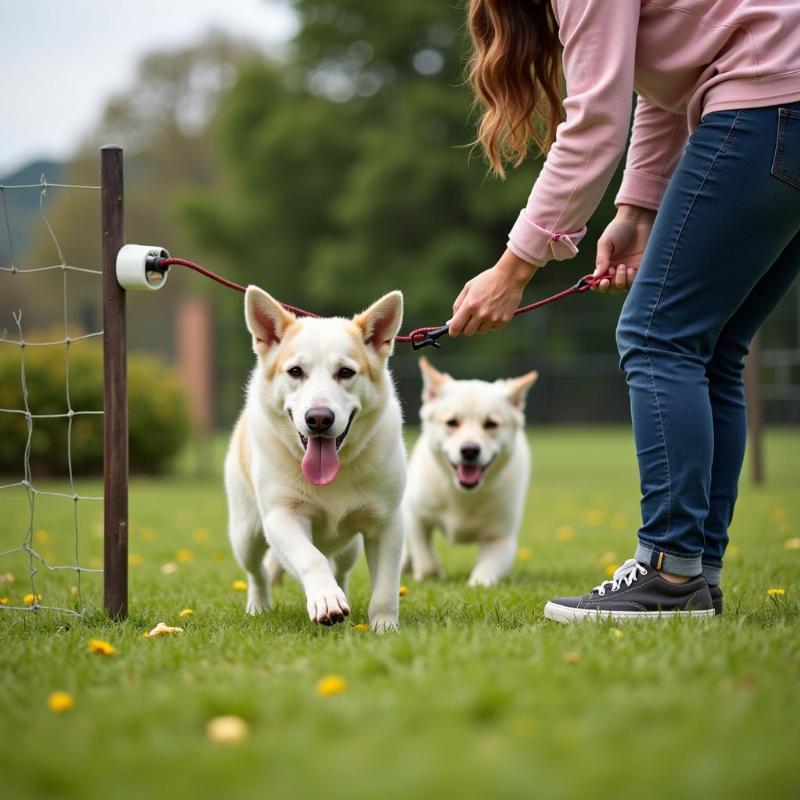Electric fence kits for dogs are a popular containment solution for pet owners in the US. They offer a flexible and often more affordable alternative to traditional fencing, allowing dogs to enjoy a designated outdoor space while staying safely within boundaries. However, choosing and installing an electric fence kit requires careful consideration to ensure your dog’s safety and well-being. This guide will provide you with all the information you need to make an informed decision about electric fences for your furry friend.
Understanding Electric Fence Kits for Dogs
An electric fence kit uses a transmitter to send a radio signal to a collar worn by your dog. A buried wire or above-ground wire creates the boundary. When your dog approaches the boundary, the collar emits a warning tone. If they continue, they receive a mild static correction. This correction is not harmful, but it’s unpleasant enough to deter them from crossing the line. Electric fences are not recommended for all dogs and should never be used as a replacement for training and socialization.
Choosing the Right Electric Fence Kit
Choosing the right electric fence kit involves considering your dog’s temperament, size, and the layout of your property. Some kits are designed for smaller dogs with milder temperaments, while others are better suited for larger, more stubborn breeds. The size of your property also dictates the length of wire you’ll need. Look for features like adjustable correction levels, waterproof collars, and multiple dog compatibility.
Factors to Consider When Choosing a Kit
- Dog’s Temperament: Is your dog easily trained or more independent? A milder correction level might be suitable for a sensitive dog, whereas a more persistent dog might need a higher setting.
- Breed and Size: Some breeds are more prone to roaming than others. Consider your dog’s breed and size when selecting a collar and correction level.
- Property Size and Layout: Measure your property accurately to determine the wire length needed. Consider any obstacles, like trees or slopes, that might affect the signal.
- Features: Look for features like adjustable correction levels, waterproof collars, and the ability to add collars for multiple dogs.
Installing Your Electric Fence Kit
Proper installation is crucial for the effectiveness of your electric fence. Follow the manufacturer’s instructions carefully. Typically, this involves burying or laying the boundary wire, connecting it to the transmitter, and testing the system.
Step-by-Step Installation Guide
- Plan Your Boundary: Clearly mark the boundary area using flags before installing the wire.
- Install the Wire: Bury the wire a few inches underground or use above-ground wire attached to existing fences or stakes.
- Connect the Transmitter: Plug in the transmitter and adjust the correction level according to your dog’s needs.
- Test the System: Use a test tool to ensure the signal is consistent along the boundary.
- Train Your Dog: Introduce your dog to the fence gradually, using positive reinforcement and consistent training.
Training Your Dog with an Electric Fence
Training is the most critical aspect of using an electric fence. Introduce your dog to the fence slowly and positively. Walk them along the boundary line, allowing them to hear the warning tone. Reward them for staying within the designated area. Never leave your dog unsupervised with the electric fence until they are fully trained.
 Training a Dog with an Electric Fence
Training a Dog with an Electric Fence
Safety and Considerations
While electric fences are generally safe, there are some important safety considerations to keep in mind.
- Supervision: Never leave your dog unsupervised with the electric fence, especially during initial training.
- Collar Fit: Ensure the collar fits snugly but not too tight. Check regularly for any signs of irritation.
- Maintenance: Inspect the fence regularly for any damage or breaks in the wire.
- Other Animals: Be aware that other animals can trigger the fence, and your dog could still be attacked by animals entering the contained area.
Conclusion
Electric fence kits for dogs can be an effective containment solution when used responsibly and with proper training. Choosing the right kit, installing it correctly, and dedicating time to training are essential for your dog’s safety and the system’s effectiveness. By following the guidelines in this comprehensive guide, you can ensure your furry friend enjoys a safe and secure outdoor space. Remember that an electric fence should never replace proper training, socialization, and regular exercise.
FAQ
- Are electric fences cruel? No, electric fences are not cruel when used correctly. The correction is a mild static pulse, not a shock.
- How long does it take to train a dog with an electric fence? Training time varies, but it usually takes a few weeks of consistent training.
- Can I use an electric fence with multiple dogs? Yes, many kits allow you to add collars for multiple dogs.
- What do I do if my dog keeps running through the fence? Check the collar fit, correction level, and the fence for any damage. Consult a professional trainer if necessary.
- Are there any alternatives to electric fences? Yes, traditional fencing, invisible fences, and tie-outs are some alternatives.
- Can electric fences be used for puppies? It’s generally recommended to wait until a puppy is at least six months old before using an electric fence.
- What should I do if the power goes out? Most systems have battery backups, but it’s important to have a backup plan in case of extended power outages.
Related Articles
Beautdogs.us is your leading resource for comprehensive dog care information, breed insights, and product recommendations. Whether you’re a new dog owner or a seasoned pro, we offer expert advice and valuable resources to help you navigate the joys and challenges of dog ownership. We specialize in helping you find the perfect products for your furry friend. Contact us for more information at [email protected] or +1 501-555-7529. Visit Beautdogs.us today!